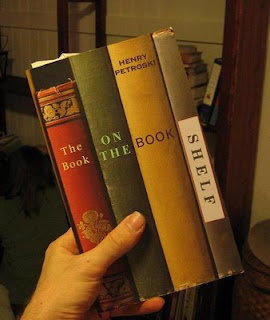
I have a pile of oak staves waiting to be turned into something useful, a razor-sharp draw knife in my hand and a far away look in my eye. Like almost all of my best hand tools, the knife was left to me by my grandpa, who taught me an enormous amount about how to make wood do what I want it to.
They never cut themselves. Never even came close as far as I know. This might've been because they wore heavy jackets, but it was probably a combination of the way you hold a drawknife and the breadth of the blade, they might not even have been in any danger of doing so, but it still seems to me to be an unnecessary risk.
When I inherited grandpa's drawknife, it was put away until I built a proper shaving horse. Because though dad and grandpa lived charmed lives (at least where draw knives are concerned) I do not. I'm clumsy and need to stack the odds in my favor.
What? You thought this would be a history of the shaving horse rather than a history of why I think I need one?
Fine, be that way.
 |
| Image Source: Wikimedia Commons |
The picture above is the stereotypical shaving horse from a 19th century book of trades.
The shaving horse is a key element of the cooper's art and mystery. It is, in effect, a foot-powered vice designed to hold wooden slats as they are shaped. The user straddles what amounts to a modified sawhorse with their feet on the pegs at the bottom of a timber that is hinged where it passes through the top of the horse.
 |
Note: Sadly, the hovering shaving horse didn't pan out, so I put legs on mine.
|
By pushing away with your feet you apply pressure to the top of a slanted portion of the horse, pinching your workpiece in place.
Here's a picture and you should go back and watch the video of the cooper at Colonial Williamsburg that I posted last week to see it in action.
So much safer than holding the stave against your tummy. Don't worry, mom, I'll be wearing a leather apron anyway.
Just in case.
Is it period-appropriate for a 16th century cooper?
I was a bit surprised to discover that this is a controversial question in certain circles.
A rudimentary shaving horse is depicted in use in the 1556 book De Re Metallica. For the record, it's shown being utilized by a miner to make bertte, a wood billet with shavings left attached to be used as fire-starters. In the case of the miners in the etching, to light fires in a mine to fracture rock.
 |
| Bertie makes the best bertte in all of Bavaria! |
.jpg) |
| Photo Source: Stadtbibliothek Nuernberg |
This is mine...
It's worth nothing that none of the shaving horses I've found have the angled surface that mine (and every other shaving horse I've ever seen) has. That slanted piece makes shaving with knife or spokeshave easier, but would preclude using the horse as a work surface as that second monk was doing.
It might be a later addition to the design; I'm not sure and don't have any data one way or the other on that topic. Mine has the slanted second level and I'm not planning to remove it so we'll make a note of it and move on.
~Scott
----
I was flipping through NetFlix videos and found an episode of Dirty Jobs where he learned to make a wine barrel. Hilarity ensues...
http://videos.howstuffworks.com/discovery/27751-dirty-jobs-building-a-barrel-video.htm

.jpg)
.jpg)


.jpg)
.png)


.jpg)

.jpg)
.jpg)
.jpg)

.jpg)
.jpg)

.jpg)




